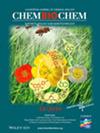Cover Feature: Characterization of ActVI-ORF3 and ActVI-ORF4 as Lactonizing and Delactonizing Enzymes in Relation to Metabolic Flux in Actinorhodin Biosynthesis (ChemBioChem 9/2025)
IF 2.6
4区 生物学
Q3 BIOCHEMISTRY & MOLECULAR BIOLOGY
引用次数: 0
Abstract
The front cover shows the biosynthetic pathway of actinorhodin (ACT), a tricyclic dimer polyketide. ACT is biosynthesized from malonyl-CoA units by multiple enzymes (blue arrow) via monomeric DHK-OH. Intracellular ACT and DHK-OH are converted into their lactone-forms (yellow arrow) diffusible outside the cell. ActVI-ORF4 can reducibly delactonize KAL-OH to DHK-OH (green arrow), but not γ-ACT. Therefore, these two enzymes could appear to efficiently regulate metabolic flux in ACT biosynthesis. More details can be found in article 10.1002/cbic.202500049 by Makoto Hashimoto, Koji Ichinose, and co-workers.

封面专题:ActVI-ORF3和ActVI-ORF4作为内酯化酶和去乙酰化酶与放线鸟素生物合成代谢通量的关系(ChemBioChem 9/2025)
前封面展示了放线鸟素(ACT)的生物合成途径,ACT是一种三环二聚体聚酮。ACT是由丙二酰辅酶a单元通过单体DHK-OH通过多种酶(蓝色箭头)生物合成的。细胞内ACT和DHK-OH被转化为内酯形式(黄色箭头),扩散到细胞外。acti - orf4能将KAL-OH还原为DHK-OH(绿箭头),但不能将γ-ACT还原。因此,这两种酶似乎可以有效地调节ACT生物合成中的代谢通量。更多细节可以在第10.1002/ cic条中找到。202500049作者:Makoto Hashimoto, Koji Ichinose及其同事。
本文章由计算机程序翻译,如有差异,请以英文原文为准。
求助全文
约1分钟内获得全文
求助全文
来源期刊

ChemBioChem
生物-生化与分子生物学
CiteScore
6.10
自引率
3.10%
发文量
407
审稿时长
1 months
期刊介绍:
ChemBioChem (Impact Factor 2018: 2.641) publishes important breakthroughs across all areas at the interface of chemistry and biology, including the fields of chemical biology, bioorganic chemistry, bioinorganic chemistry, synthetic biology, biocatalysis, bionanotechnology, and biomaterials. It is published on behalf of Chemistry Europe, an association of 16 European chemical societies, and supported by the Asian Chemical Editorial Society (ACES).
 求助内容:
求助内容: 应助结果提醒方式:
应助结果提醒方式:


